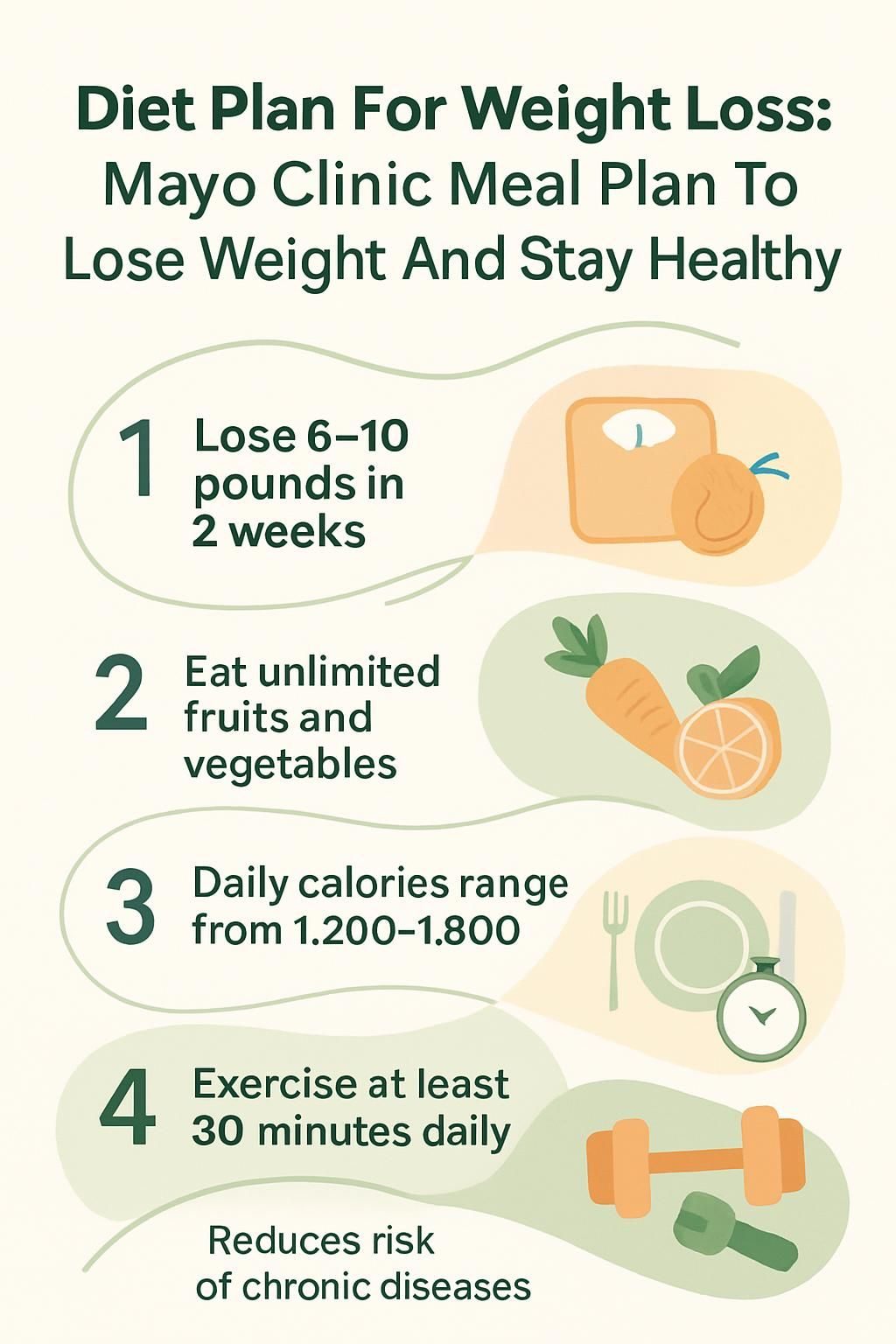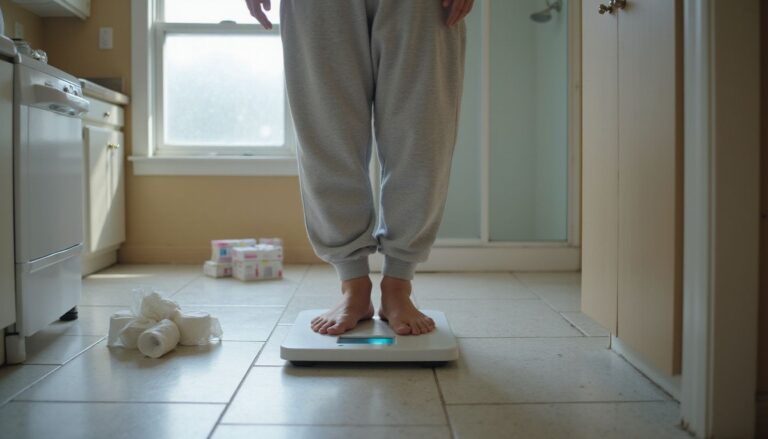Diet Plan For Weight Loss: Mayo Clinic Meal Plan To Lose Weight And Stay Healthy
Our Nutrition Assistant AI Suite will transform your body. You will lose fat, get toned, and build muscle. Gain confidence and optimal health.
If you have searched for a diet plan for weight loss that feels doable, you are not alone. The Mayo Clinic Diet is a proven eating plan that helps you lose weight and build healthy habits that last. This approach favors simple, steady steps over strict rules and crash diets.
In this guide, you will see how the Mayo Clinic meal plan supports steady weight loss, encourages healthy eating, and can lower risks linked to heart disease or type 2 diabetes. You will also learn how small changes in your daily meals can lead to real health benefits.
Ready to start your next chapter with a clear, practical plan? Keep reading for simple actions that fit your life and help you feel your best.
Key Takeaways
- The Mayo Clinic Diet uses two phases, “LOSE IT!” for a quick start with 6 to 10 pounds lost in two weeks, then “LIVE IT!” for steady progress of 1 to 2 pounds per week.
- Vegetables and fruits form the base of the plan. Whole grains, lean proteins in reasonable portions, healthy fats, and low-fat dairy round out your plate.
- Daily calorie targets typically range from 1,200 to 1,800. Sweets are limited to about 75 calories per day under Mayo Clinic guidelines.
- Physical activity matters. Aim for at least 30 minutes daily to support weight management and heart health.[1]
- Research suggests this approach may reduce risks tied to type 2 diabetes, high blood pressure, sleep apnea, and coronary artery disease through better nutrition and consistent habits.[1][2]

Understanding the Mayo Clinic Diet

The Mayo Clinic Diet gives you a clear structure for healthy eating and long-term weight management. Think of it as a roadmap that helps you keep a healthy weight and lower your risk of problems like high blood pressure and type 2 diabetes.
What is the Mayo Clinic Diet?
Created by Mayo Clinic experts, this eating plan focuses on lifelong habits. You increase fruits and vegetables, choose whole foods, and move your body more each day. These steps help you lose excess weight without cutting entire food groups.
The plan avoids strict calorie counting. Instead, it leans on unlimited vegetables and fruits to keep meals filling but lower in calories. You follow two phases. First is “LOSE IT!” for two weeks to jump-start weight loss. Second is “LIVE IT!” for ongoing healthy living and maintenance.
The Mayo Clinic Diet focuses on reshaping lifestyle habits instead of short-term dieting.
This program may help lower risk factors linked to obesity, high cholesterol, and hypertension. It supports a balanced diet rich in whole grains and nutrient-dense foods that keep you satisfied.
Why is the Mayo Clinic Diet a sustainable weight-loss program?
The plan teaches skills you can use for life. The “LOSE IT!” phase helps you drop 6 to 10 pounds in two weeks, which builds early momentum. Then the “LIVE IT!” phase guides safe, steady loss of 1 to 2 pounds per week until you reach a healthy weight.
Simple tools like meal planners, food journals, and progress trackers help you stay accountable. The plan is flexible, so you can fit it to your taste and culture. Learning portion control and choosing high fiber foods can help you feel full without counting every bite. These habits also support heart health and better blood sugar control.
Professional guidance helps you replace old routines with new ones that support long-term weight management.
Core Principles of the Mayo Clinic Diet
The Mayo Clinic Diet centers on healthy habits that make weight control easier. You will plan meals that are low in calories and high in nutrients to support your long-term health.
How does the Mayo Clinic Diet promote healthy eating habits?
Fill your plate with vegetables, fruits, beans, and whole grains. These foods are rich in dietary fiber and tend to be low in calories, which helps you feel satisfied. Non-starchy vegetables are unlimited, and fruits are encouraged, so you do not need to feel hungry.
Round out your meals with nuts, fish, lean proteins, and healthy fats from olive oil or avocado. Portion control matters. Desserts can fit the plan, but aim for about 75 calories per day, such as a small piece of chocolate.
In the “LOSE IT!” phase, you drop five unhealthy habits and add five positive ones. For example, you might stop eating while watching TV and start prepping yogurt or bean salads for late-night cravings.
I started prepping fresh veggies for my snacks based on the Mayo Clinic’s advice.It took a few minutes after work and made it easier to stick to my goals, says Sarah from Minnesota.
These simple routines change how you shop, cook, and eat. They support real progress without extreme rules.
How can physical activity boost weight loss on this diet?
Physical activity helps you burn calories and protect muscle. Experts recommend at least 30 minutes of movement daily. More activity can lead to faster fat loss and better fitness.
Walking, jogging, cycling, or resistance training support your metabolism. Small choices add up. Take the stairs, park farther away, or walk during calls. If you are new to exercise or have medical concerns, start with ten-minute sessions and build from there.
Pairing movement with this eating plan often improves heart health and blood sugar control compared with dieting alone.[1][2]
What long-term lifestyle changes does the diet encourage?
This plan encourages daily routines that support weight control for life. Practice mindful eating, learn portion sizes, and choose nutrient-dense foods like vegetables, fruits, whole grains, nuts, lean proteins, and low-fat dairy.
Plan meals ahead to avoid high-sugar, calorie-dense snacks. Keep a steady sleep schedule because too little sleep can affect blood sugar and hunger. Track your food to spot patterns and make small fixes.
Program tools teach problem-solving, so a setback does not undo your progress. Step by step, you build lasting habits that support a healthy weight and better overall health.
Steady loss of 0.5 to 1 pound per week tends to lead to better maintenance over time.[1]
The Mayo Clinic Healthy Weight Pyramid
The Mayo Clinic Healthy Weight Pyramid is a simple picture of how to build your plate. It guides your choices so you get more nutrition for fewer calories.
What is the Healthy Weight Pyramid?
The pyramid was created by Mayo Clinic experts to guide daily eating. The base is vegetables and fruits, which you should eat most often. Above that are grains, especially whole grains like brown rice and oats, and lean proteins such as fish or beans.
Low-fat dairy fits into the next level. Nuts provide healthy fats that support your body and keep you full. High-sugar snacks and rich desserts sit at the very top. Eat those less often and in small portions.
Focusing on food groups and portions, instead of strict calorie counting, makes the plan easier to follow. Many people find this visual helps them plan satisfying meals that support healthy weight loss.
How do you balance food groups for weight loss and health?
Use the pyramid to build each meal. Start with a generous serving of vegetables and fruit for fiber, vitamins, and minerals. Add whole grains such as brown rice or whole wheat bread for steady energy.
Include a moderate portion of lean protein like grilled chicken, beans, or fish to help you feel full. Choose healthy fats from sources like nuts, olive oil, or avocados, but keep the amounts small since fats are calorie-dense. Limit desserts to roughly 75 calories per day to enjoy treats without stalling progress.
Pick low-fat dairy for protein and calcium. This balanced approach works for many people, including those who need carbohydrate control or doctor-supervised very-low-calorie plans.
A simple example helps: a colorful salad topped with grilled salmon, a small side of brown rice, and a piece of fruit keeps hunger away without heavy calories. You do not need extreme rules that cut out whole food groups.
Benefits of the Mayo Clinic Diet
This eating plan favors safe, steady weight loss and healthy habits for the long run. You learn patterns that are easier to maintain than tight short-term diets.
How does this diet promote steady, sustainable weight loss?
The “LOSE IT!” phase helps many people lose 6 to 10 pounds in two weeks. That early win can boost your confidence. Next, “LIVE IT!” guides a loss of about 1 to 2 pounds per week until you reach your goal.
You build balanced meals with fruits, vegetables, whole grains, and lean proteins. Meals are filling but lower in calories. No need to cut entire food groups. One reader shared that this plan felt easier to keep than restrictive approaches that banned favorite foods.
Can the diet reduce the risk of chronic diseases?
Eating more vegetables, fruits, whole grains, nuts, beans, and healthy fats is linked with better heart health and improved blood sugar. The Mayo Clinic Diet stresses these foods, which can help reduce the risk of type 2 diabetes, high blood pressure, obesity, and sleep apnea.
Large waists, over 35 inches for women and over 40 inches for men, mark higher risk. Losing weight and improving your diet can improve cholesterol, blood sugar, and blood pressure.
Many people report better lab results after following the plan, which aligns with heart-healthy guidance from major organizations.[1][2]
How does it encourage a healthier relationship with food?
The plan teaches you to eat without distractions so you notice hunger and fullness signals. You focus on plenty of produce, which adds volume and nutrients without many calories.
Dietitian tips and recipes make meal planning simpler and less stressful. You build new routines and reduce mindless snacking or emotional eating. Over time, meals feel more enjoyable and less tense.
How the Mayo Clinic Meal Plan Works
The Mayo Clinic meal plan guides you to choose nutrient-dense foods and daily habits that match your weight-loss goals. Small changes add up to steady progress.
How does portion control work in this meal plan?
Portion control follows the Healthy Weight Pyramid. Each food group has suggested serving sizes to keep calories in check. Daily meal plans are often set at 1,200 to 1,800 calories.
Focus on portions instead of strict calorie counting. For example, include at least one or two servings of vegetables or fruit at meals, and about 3 to 5 ounces of lean protein to support fullness. Keep desserts to around 75 calories per day.
Sample menus show how to combine grains, lean proteins, low-fat dairy, nuts and seeds, healthy fats, and produce without feeling deprived.
Why are nutrient-dense foods important in the plan?
Nutrient-dense foods deliver vitamins, minerals, and fiber with fewer calories. Fruits, vegetables, whole grains, nuts, beans, and fish offer a lot of nutrition per bite.
Fiber helps you feel full, and pairing it with lean protein supports muscle while you lose weight. Healthy fats from nuts and seeds add lasting energy, especially when you avoid ultra-processed sweets.
This focus can lower the risk of diabetes and heart disease, while helping you reach a healthy weight.[1][2]
What role does physical activity play in the program?
Activity is a core part of the Mayo Clinic Diet. Aim for at least 30 minutes a day. Extra movement can accelerate results.
Mix aerobic exercise like brisk walking with resistance training to support strength and metabolism. If you are easing back into fitness, begin with short bouts and build duration over time. Speak with your healthcare provider if you have medical conditions.
Short walks after meals can help you reach your goal without feeling overwhelmed. Adding steps across your day makes these habits easier to keep.
Sample 3-Day Meal Plan
This sample menu highlights fruits, vegetables, whole grains, lean proteins, and nuts for balanced eating that supports weight loss. Adjust portions to meet your calorie needs.
What are healthy breakfast, lunch, and dinner ideas for Day 1?
Breakfast: overnight oats topped with berries and sliced pear for fiber and steady energy. Lunch: Tuscan white bean soup with a drizzle of pesto. The beans offer protein and help you feel full.
Dinner: sheet-pan roast chicken with broccolini, onions, and tomatoes. This meal fits Mediterranean-style eating, which favors whole foods and healthy fats. Snack ideas: sliced bell peppers and a banana. Keep desserts near 75 calories to stay on track.
What balanced meals support weight loss on Day 2?
Breakfast: steel-cut oats with banana and chopped walnuts. You get fiber plus healthy fat from the nuts. Lunch: Mediterranean salad with leafy greens, tomatoes, cucumbers, grilled chicken breast, chickpeas, olive oil, and lemon juice. This mix supports heart health and steady energy.
Snack on baby carrots or apple slices since both are low in calories and high in fiber. Dinner: baked salmon with roasted broccoli and bell peppers plus brown rice. These choices fit a 1,200-calorie framework for many adults, though some need more calories for health or activity levels.
What low-calorie but satisfying meals can you have on Day 3?
Keep the same balance with simple, filling meals. Breakfast: steel-cut oats topped with fresh berries for fiber and antioxidants. Lunch: spinach salad with grilled chicken breast for protein and steady energy.
Dinner: roast salmon with steamed broccoli and brown rice. Snacks: apple slices with nut butter or nonfat Greek yogurt. These choices are nutrient-dense, which helps prevent overeating between meals.
Here is a quick nutrition snapshot for Day 3.
| Meal | Calories | Protein (g) | Fiber (g) |
|---|---|---|---|
| Steel-Cut Oats + Berries | 180 | 5 | 6 |
| Spinach Salad + Grilled Chicken | 320 | 32 | 7 |
| Salmon + Broccoli + Brown Rice | 400 | 29 | 6 |
| Apple Slices + Nut Butter | 150 | 3 | 4 |
Each meal includes produce plus a whole grain or lean protein. That mix supports nutrition and keeps meals interesting.
Foods to Include in the Mayo Clinic Diet
The Mayo Clinic Diet highlights foods that are high in nutrients and help with weight control. These choices support a healthy immune system and protect your heart.
Why include vegetables and fruits in the diet?
Vegetables and fruits make up the base of the Healthy Weight Pyramid. You can eat plenty because they are high in fiber and low in calories. This combination helps you stay full while eating fewer calories.
They also supply vitamins, minerals, and antioxidants that support immune health. Higher intake is linked with a lower risk of diabetes and heart disease. If you have diabetes, favor non-starchy vegetables and match fruit portions to your plan to help manage blood sugar.
What whole grains and lean proteins are recommended?
Choose whole grains like brown rice, quinoa, oats, whole wheat bread, and barley. These provide fiber for digestion and long-lasting energy.
Lean proteins include fish, skinless chicken breast, turkey, beans, lentils, and tofu. Aim for about 3 to 5 ounces of lean protein per meal to help maintain muscle while limiting calories. Beans offer both protein and fiber, and nuts add healthy fat that supports fullness.
Pairing these foods with vegetables and fruits supports steady progress while meeting your nutrient needs.
Which healthy fats and low-fat dairy should you eat?
Healthy fats come from nuts like almonds or walnuts, fatty fish like salmon or trout, and plant oils such as olive oil. These provide unsaturated fats that support heart health and promote satiety. Use modest amounts to balance calories.
Pick low-fat dairy such as skim milk, reduced-fat cheese, or nonfat yogurt. These options deliver calcium and protein without too much saturated fat or extra calories. A registered dietitian can help you plan portions that fit your goals.
Foods to Limit or Avoid
Some foods make weight loss harder because they pack many calories with few nutrients. Swapping them for whole foods can make a real difference.
Why avoid processed and high-sugar foods?
Many processed foods contain unhealthy fats, additives, and added sugars. These can spike blood sugar and add extra calories without needed nutrients. Over time, this pattern can lead to weight gain and higher health risks.
Limiting these foods encourages you to fill your plate with whole, nutrient-dense choices, like vegetables, fruits, whole grains, and lean proteins. People often notice better digestion and more stable energy when they cut back on ultra-processed items.
What are refined carbohydrates and why limit them?
Refined carbohydrates, like white bread and pastries, have most of their fiber and nutrients removed. Your body absorbs them quickly, which can spike blood sugar and then leave you hungry soon after.
Replacing refined grains with whole grains such as brown rice or whole-wheat pasta helps keep energy steady and supports weight control. Over time, this swap can reduce the risk of chronic health problems tied to poor diet quality.
Which high-fat, calorie-dense snacks should be avoided?
Fried foods, chips, and rich desserts are easy to overeat. They deliver many calories and few nutrients. Most of these snacks exceed the plan’s 75-calorie dessert guideline with just a small serving.
| Snack Type | Example | Calories per Serving |
|---|---|---|
| Fried Snacks | Potato Chips | 150 to 200 |
| Sugary Desserts | Doughnut | 250 to 300 |
| Fast Food Sides | French Fries | 300+ |
Choose produce, yogurt, or a small portion of nuts instead. These swaps cut calories and keep you full longer.
Tips for Success on the Mayo Clinic Diet
Small, consistent steps help you stick with the plan. Use these ideas to stay on track and keep motivation steady.
How do you set realistic weight-loss goals?
Use your current weight, height, and BMI to set a starting target. Healthy adult BMI is 18.5 to 24.9. Expect to lose 6 to 10 pounds in the “LOSE IT!” phase, then aim for 1 to 2 pounds per week in “LIVE IT!”.
Track your waist because higher measures raise health risks. For many adults, daily calories fall between 1,200 and 1,800 on this plan, though needs vary. A simple app or journal makes goal tracking easier.
Breaking a big goal into smaller milestones can make progress feel more achievable week by week.
What are effective ways to track progress and stay motivated?
Log your meals, snacks, and workouts each day. Digital trackers can send reminders and show trends. Weigh in weekly, and note waist measurements and BMI. These add context beyond the scale.
Keep an eye on health markers like blood pressure or cholesterol if your clinician recommends it. Early results from the “LOSE IT!” phase can boost motivation. If you need support, look for coaching or group tools inside the program.
How can you incorporate regular exercise into your routine?
Pick activities that fit your day, like 30 minutes of walking or taking the stairs at work. If you are new to exercise or have a medical condition, begin with five to ten minutes and build slowly.
Combine aerobic activities with basic resistance training to protect muscle. Many people like using step counters or fitness apps to track daily movement. Speak with your healthcare provider before starting if you have health concerns.
Portion control and smart meal planning will boost the benefits of regular exercise.
Common Myths About the Mayo Clinic Diet
Myths can lead to confusion. Knowing the facts helps you use the plan with confidence.
Is the Mayo Clinic Diet a fad diet?
No. The Mayo Clinic Diet was developed by medical professionals and is based on research. You do not cut entire food groups or follow extreme rules. You build habits you can maintain for life.
Health professionals favor this approach because it targets 1 to 2 pounds per week, a safe pace that supports long-term success. Many people find these gradual changes easier to maintain than strict short-term plans.
Does following the diet require expensive ingredients?
No. The plan uses everyday foods like vegetables, fruits, beans, whole grains, and basic lean proteins. Portion control and weekly planning help you shop on a budget.
No pricey supplements or specialty products are required. A simple grocery list, based on your meals for the week, can cut costs and food waste.
Risks and Considerations
Most healthy adults can follow this plan. Some people need extra guidance for safety. This information is educational and not medical advice. Talk with your clinician if you have questions about your health.
Who should consult a doctor before starting this diet?
Consult a clinician if you have diabetes, heart disease, kidney issues, or thyroid concerns. You may need changes to medicines or meal timing. People who are mostly inactive or plan to increase exercise should also ask for guidance first.
Some adults need more than 1,200 calories per day. A professional can help you set a safe calorie level and adjust as needed. Children and teens should work with a pediatric clinician to support healthy growth.
What challenges might beginners face on the diet?
Shifting to more fiber can cause brief bloating or gas. This usually settles as your body adapts. Portion control and a daily 75-calorie dessert limit can feel new at first.
High fruit intake can affect blood sugar if portions are large, especially for people with diabetes. Tracking meals and planning ahead helps you handle busy days and stay consistent.
Comparing the Mayo Clinic Diet with Other Diet Plans
Seeing how this plan stacks up can help you choose the right approach for your goals.
How does it differ from fad diets?
The Mayo Clinic Diet does not cut entire food groups or demand strict calorie counting. You focus on habits, high-fiber foods, and balanced meals. Medical experts designed it for lifelong use, not quick fixes.
Fad diets often promise rapid results with unproven methods or extreme restrictions. This plan uses evidence-based steps that support steady progress and better health markers over time.
How does it align with other healthy eating approaches?
The plan shares ideas with other respected patterns, including Mediterranean-style eating. It highlights vegetables, fruits, whole grains, nuts, beans, fish, and healthy fats. These principles match guidance from the U.S. Departments of Health and Human Services and Agriculture.
Major groups like the American Cancer Society and the National Heart, Lung, and Blood Institute encourage similar habits. You can feel confident that this approach supports both weight goals and overall well-being.[2][3]
Results You Can Expect
This plan aims for steady results that last. Many people also see gains in energy, mood, and day-to-day confidence.
What are typical weight-loss outcomes from this diet?
Most people lose 6 to 10 pounds during the two-week “LOSE IT!” phase. After that, expect about 1 to 2 pounds per week in the “LIVE IT!” phase. These results come from sustainable changes and higher intake of nutrient-dense foods.
Progress varies. Your starting weight, age, health, and activity level all matter. The key is consistent habits that you can keep.
What long-term health benefits can you expect?
Losing 5 to 10 percent of your body weight can lower blood pressure, improve cholesterol, and help control blood sugar.[2] These changes may reduce the risk of heart disease and diabetes.
People often report more energy, better digestion, and a higher quality of life after several months on the plan. Keeping up with these habits supports long-term maintenance.
Maintaining Weight Loss with the Mayo Clinic Diet
Maintenance is about staying consistent with the habits you learned. Small daily actions protect your results.
How can you sustain weight loss results?
After the “LOSE IT!” phase, shift into “LIVE IT!” and continue slow, steady loss until you reach your goal. Aim for at least 30 minutes of daily movement. Brisk walking counts and is easy to keep.
Track meals and activity with a journal or app. Seeing your habits on paper can help you avoid old patterns. Many people find this simple step prevents weight regain.
What does transitioning to a maintenance phase involve?
Maintenance means keeping the same core habits. Keep moving daily, plan balanced meals, and continue using your tracking tools. That accountability helps you spot risks and make quick adjustments.
Focus on plenty of fruits and vegetables to anchor each day. Let go of strict calorie counting and aim for consistency. A small swap, like apple slices instead of a pastry, can protect your progress while keeping meals enjoyable.
Conclusion
The Mayo Clinic Diet offers a clear, evidence-informed way to lose weight and strengthen daily habits. You build meals around vegetables, fruits, whole grains, lean proteins, and healthy fats, then use portion control and activity to guide steady results. This approach can lower risk factors linked to diabetes and heart disease and help you maintain a healthy weight long term.
Start with small steps, keep your routines simple, and use tracking to stay on course. With patience and practice, this meal plan can help you lose weight and feel healthier.
References: [1] Mayo Clinic Staff, Mayo Clinic Diet resources and articles. [2] U.S. Department of Health and Human Services and U.S. Department of Agriculture, Dietary Guidelines for Americans. [3] National Heart, Lung, and Blood Institute, Aim for a Healthy Weight.
FAQs
1. What is the Mayo Clinic meal plan for weight loss?
The Mayo Clinic meal plan focuses on nutrient-rich foods like fruits, vegetables, whole grains, and lean proteins. It encourages portion control and regular meals to help people lose weight in a healthy way.
2. How does the Mayo Clinic diet support long-term health?
This diet promotes balanced nutrition by limiting added sugars and saturated fats while increasing fiber intake from plant-based foods. Studies show that these habits can lower risks of heart disease and diabetes.
3. Can I see results with the Mayo Clinic meal plan without extreme calorie restriction?
Yes; research indicates that gradual changes such as eating more vegetables or choosing whole grains over refined options lead to steady weight loss without severe calorie cuts.
4. Is there evidence supporting the effectiveness of this diet for losing weight?
Clinical trials published in peer-reviewed journals report that participants following structured plans like the Mayo Clinic’s lost an average of 6 to 10 pounds over several weeks when combined with physical activity.
Summary: The Mayo Clinic meal plan uses science-backed strategies including portion control, increased fiber, reduced sugar, and regular exercise to promote safe weight loss and better health outcomes. Personal experience shows that small daily changes make it easier to maintain progress over time.







